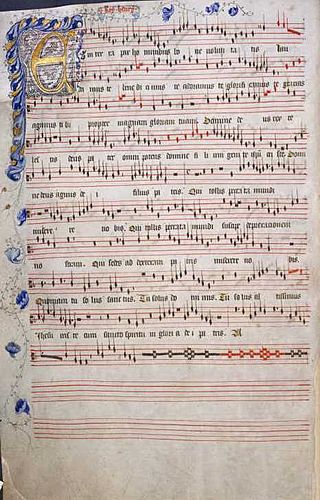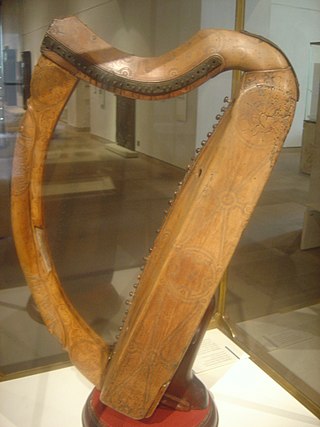
Medieval music encompasses the sacred and secular music of Western Europe during the Middle Ages, from approximately the 6th to 15th centuries. It is the first and longest major era of Western classical music and followed by the Renaissance music; the two eras comprise what musicologists generally term as early music, preceding the common practice period. Following the traditional division of the Middle Ages, medieval music can be divided into Early (500–1150), High (1000–1300), and Late (1300–1400) medieval music.

Renaissance music is traditionally understood to cover European music of the 15th and 16th centuries, later than the Renaissance era as it is understood in other disciplines. Rather than starting from the early 14th-century ars nova, the Trecento music was treated by musicology as a coda to Medieval music and the new era dated from the rise of triadic harmony and the spread of the contenance angloise style from Britain to the Burgundian School. A convenient watershed for its end is the adoption of basso continuo at the beginning of the Baroque period.

Gilles de Bins dit Binchois was a Franco-Flemish composer of early Renaissance music. A central figure of the Burgundian School, Binchois and his colleague Guillaume Du Fay were deeply influenced by the contenance angloise style of John Dunstaple. His efforts in consolidating a 'Burgundian tradition' would be important for the formation of the Franco-Flemish School. One of the three most famous composers of the early 15th century, Binchois is often ranked behind Du Fay and Dunstable by contemporary scholars, but his works were still widely cited, emulated and used as source material after his death.
The designation Franco-Flemish School, also called Netherlandish School, Burgundian School, Low Countries School, Flemish School, Dutch School, or Northern School, refers, somewhat imprecisely, to the style of polyphonic vocal music composition originating from France and from the Burgundian Netherlands in the 15th and 16th centuries as well as to the composers who wrote it. The spread of their technique, especially after the revolutionary development of printing, produced the first true international style since the unification of Gregorian chant in the 9th century. Franco-Flemish composers mainly wrote sacred music, primarily masses, motets, and hymns.

Guillaume Du Fay was a French composer and music theorist of the early Renaissance. Considered the leading European composer of his time, his music was widely performed and reproduced. Du Fay was well-associated with composers of the Burgundian School, particularly his colleague Gilles Binchois, but was never a regular member of the Burgundian chapel himself.

John Dunstaple was an English composer whose music helped inaugurate the transition from the medieval to the Renaissance periods. The central proponent of the Contenance angloise style, Dunstaple was the leading English composer of his time, and is often coupled with William Byrd and Henry Purcell as England's most important early music composers. His surviving music is exclusively vocal, and frequently uses isorhythms, while pioneering the prominent use of harmonies with thirds and sixths. His style would have an immense influence on the subsequent music of continental Europe, inspiring composers such as Du Fay, Binchois, Ockeghem and Busnois.

The Burgundian School was a group of composers active in the 15th century in what is now northern and eastern France, Belgium, and the Netherlands, centered on the court of the Dukes of Burgundy. The school inaugurated the music of Burgundy.

The English Renaissance was a cultural and artistic movement in England from the early 16th century to the early 17th century. It is associated with the pan-European Renaissance that is usually regarded as beginning in Italy in the late 14th century. As in most of the rest of northern Europe, England saw little of these developments until more than a century later within the Northern Renaissance. Renaissance style and ideas were slow to penetrate England, and the Elizabethan era in the second half of the 16th century is usually regarded as the height of the English Renaissance. Many scholars see its beginnings in the early 16th century during the reign of Henry VIII.
Walter Frye was an English composer of the early Renaissance.

The Old Hall Manuscript is the largest, most complete, and most significant source of English sacred music of the late 14th and early 15th centuries, and as such represents the best source for late Medieval English music. The manuscript somehow survived the Reformation, and formerly belonged to St. Edmund's College, a Roman Catholic school located at Old Hall Green in Hertfordshire. It was sold to the British Library after an auction at Sotheby's in 1973.
Fauxbourdon – French for false drone – is a technique of musical harmonisation used in the late Middle Ages and early Renaissance, particularly by composers of the Burgundian School. Guillaume Dufay was a prominent practitioner of the form, and may have been its inventor. The homophony and mostly parallel harmony allows the text of the mostly liturgical lyrics to be understood clearly.
A descant, discant, or discantus is any of several different things in music, depending on the period in question; etymologically, the word means a voice (cantus) above or removed from others. The Harvard Dictionary of Music states:
Anglicized form of L. discantus and a variant of discant. Throughout the Middle Ages the term was used indiscriminately with other terms, such as descant. In the 17th century it took on special connotations in instrumental practice.
Martin le Franc was a French poet of the late Middle Ages and early Renaissance.

Classical music of the United Kingdom is taken in this article to mean classical music in the sense elsewhere defined, of formally composed and written music of chamber, concert and church type as distinct from popular, traditional, or folk music. The term in this sense emerged in the early 19th century, not long after the United Kingdom of Great Britain and Ireland came into existence in 1801. Composed music in these islands can be traced in musical notation back to the 13th century, with earlier origins. It has never existed in isolation from European music, but has often developed in distinctively insular ways within an international framework. Inheriting the European classical forms of the 18th century, patronage and the academy and university establishment of musical performance and training in the United Kingdom during the 19th century saw a great expansion. Similar developments occurred in the other expanding states of Europe and their empires. Within this international growth the traditions of composition and performance centred in the United Kingdom, including the various cultural strands drawn from its different provinces, have continued to evolve in distinctive ways through the work of many famous composers.

Early music of Britain and Ireland, from the earliest recorded times until the beginnings of the Baroque in the 17th century, was a diverse and rich culture, including sacred and secular music and ranging from the popular to the elite. Each of the major nations of England, Ireland, Scotland, and Wales retained unique forms of music and of instrumentation, but British music was highly influenced by continental developments, while British composers made an important contribution to many of the major movements in early music in Europe, including the polyphony of the Ars Nova and laid some of the foundations of later national and international classical music. Musicians from the British Isles also developed some distinctive forms of music, including Celtic chant, the Contenance Angloise, the rota, polyphonic votive antiphons, and the carol in the medieval era and English madrigals, lute ayres, and masques in the Renaissance era, which would lead to the development of English language opera at the height of the Baroque in the 18th century.
John Hothby, also known by his Latinised names Johannes Ottobi or Johannes de Londonis, was an English Renaissance music theorist and composer who travelled widely in Europe and gained an international reputation for his work.

Music in early modern Scotland includes all forms of musical production in Scotland between the early sixteenth century and the mid-eighteenth century. In this period the court followed the European trend for instrumental accompaniment and playing. Scottish monarchs of the sixteenth century were patrons of religious and secular music, and some were accomplished musicians. In the sixteenth century the playing of a musical instrument and singing became an expected accomplishment of noble men and women. The departure of James VI to rule in London at the Union of Crowns in 1603, meant that the Chapel Royal, Stirling Castle largely fell into disrepair and the major source of patronage was removed from the country. Important composers of the early sixteenth century included Robert Carver and David Peebles. The Lutheranism of the early Reformation was sympathetic to the incorporation of Catholic musical traditions and vernacular songs into worship, exemplified by The Gude and Godlie Ballatis (1567). However, the Calvinism that came to dominate Scottish Protestantism led to the closure of song schools, disbanding of choirs, removal of organs and the destruction of music books and manuscripts. An emphasis was placed on the Psalms, resulting in the production of a series of Psalters and the creation of a tradition of unaccompanied singing.

Music in Medieval Scotland includes all forms of musical production in what is now Scotland between the fifth century and the adoption of the Renaissance in the early sixteenth century. The sources for Scottish Medieval music are extremely limited. There are no major musical manuscripts for Scotland from before the twelfth century. There are occasional indications that there was a flourishing musical culture. Instruments included the cithara, tympanum, and chorus. Visual representations and written sources demonstrate the existence of harps in the Early Middle Ages and bagpipes and pipe organs in the Late Middle Ages. As in Ireland, there were probably filidh in Scotland, who acted as poets, musicians and historians. After this "de-gallicisation" of the Scottish court in the twelfth century, a less highly regarded order of bards took over the functions of the filidh and they would continue to act in a similar role in the Scottish Highlands and Islands into the eighteenth century.

Church music in Scotland includes all musical composition and performance of music in the context of Christian worship in Scotland, from the beginnings of Christianisation in the fifth century, to the present day. The sources for Scottish Medieval music are extremely limited due to factors including a turbulent political history, the destructive practices of the Scottish Reformation, the climate and the relatively late arrival of music printing. In the early Middle Ages, ecclesiastical music was dominated by monophonic plainchant, which led to the development of a distinct form of liturgical Celtic chant. It was superseded from the eleventh century by more complex Gregorian chant. In the High Middle Ages, the need for large numbers of singing priests to fulfill the obligations of church services led to the foundation of a system of song schools, to train boys as choristers and priests. From the thirteenth century, Scottish church music was increasingly influenced by continental developments. Monophony was replaced from the fourteenth century by the Ars Nova consisting of complex polyphony. Survivals of works from the first half of the sixteenth century indicate the quality and scope of music that was undertaken at the end of the Medieval period. The outstanding Scottish composer of the first half of the sixteenth century was Robert Carver, who produced complex polyphonic music.

Music in Medieval England, from the end of Roman rule in the fifth century until the Reformation in the sixteenth century, was a diverse and rich culture, including sacred and secular music and ranging from the popular to the elite.











